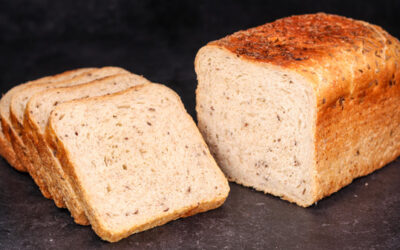Semolina is a type of wheat flour. Whereas most bread flours are made ‘common wheat’, semolina is made from ‘durum’ wheat. It has a beautiful yellow colour, which can be lighter or more intense, and an earthy sweet aroma. The texture of semolina can range from quite rough and coarse to sandy and smooth. Semolina should not be confused with polenta which may look similar but is made from corn and is totally gluten free.
Different types of semolina can be used for different purposes. Most commonly it is used in pasta and cous-cous preparation. It gives those products their distinct yellow colour. Other uses include cakes, pie and tart cases, and even some desserts or porridge. My mother used to make semolina porridge for me when I was growing up in Latvia. It was cooked with milk and eaten with jam.
Although semolina has a high protein content and it can form strong gluten, it may not aways be the best type of flour for breadmaking. Its coarser texture can hinder gluten development. You must choose the right semolina for the job. Try to find extra fine or double milled semolina. If it is specifically advertised as for bread making, then it should definitely do the job. Saying all that, you can make this recipe with regular fine semolina.
This dough can be used in a variety of ways. Boules, batards, baguettes, buns, rolls, and anything else that you may use a standard white flour dough for.
If you want to bake it on the same day, then bulk ferment for 1.5 – 2 hours with two folds at equal intervals, pre-shape and rest for 20 minutes, shape and proof for 45 – 60 minutes.
Watch the video down below for detailed instructions.
Ingredients
For the dough –
400g (14.1oz) extra fine semolina
4g (0.14oz) instant dry yeast or 4.8g (0.17oz) active dry yeast or 12g (0.42oz) fresh yeast
8g (0.28oz) salt
12g (0.42oz) olive oil
280g (9.9oz) water
To learn more about no-knead bread dough temperature control click here.
If you are using active dry yeast, then you may need to let it sit in the water for 10 minutes before adding the other ingredients or else it could take a lot longer to raise the dough.
Method
- In a large bowl combine the water, yeast, and salt. Mix well to dissolve the salt and yeast. Add the olive oil and semolina. Mix to a dough. *Desired dough temperature 25C (77F).
- Cover and refrigerate for 30 minutes.
- Fold #1
- Refrigerate for 30 minutes.
- Fold #2
- Cold ferment for 18 – 24 hours.
- On the next day remove the dough from the fridge. Pre-shape, cover, and rest for 30 minutes.
- Shape the loaf, moisten its surface and cover with seeds. Place in a proofing basket.
- Final proof 1 – 1.5 hours. *During the final hour of fermentation pre-heat the oven and the baking vessel (if you’re using one) to 220C (430F) fan on or 240C (465F) fan off.
- Score, steam, and bake with the lid on for 25 minutes.
- Remove the lid and place the bread back into the oven for 10 – 15 minutes until you’re happy with the colour of the crust.
Keep in mind that the conditions in each kitchen are different, so fermentation times may vary for you. It is up to the baker to control the bread and react accordingly.
Your oven may be different too, so your baking time may vary.



